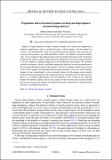Expansion and retraction dynamics in drop-on-drop impacts on nonwetting surfaces
Author(s)
Damak, Maher; Varanasi, Kripa
DownloadPhysRevFluids.3.093602.pdf (980.5Kb)
PUBLISHER_POLICY
Publisher Policy
Article is made available in accordance with the publisher's policy and may be subject to US copyright law. Please refer to the publisher's site for terms of use.
Terms of use
Metadata
Show full item recordAbstract
Impacts of liquid droplets on other stationary droplets on a surface are ubiquitous in numerous applications such as agricultural sprays, inkjet printing, and rain impact on surfaces. We experimentally study the maximum expansion diameter and retraction rate in drop-on-drop impacts on superhydrophobic surfaces. We identify an inertial-capillary and a viscous regime for the expansion phase and we interpret the results using two distinct models. In the inertial-capillary regime, the first model predicts that the maximum diameter is set by an effective capillary length due to the deceleration upon impact. We introduce an effective diameter, velocity, and Weber number that allow the accurate determination of the maximum diameter in drop-on-drop impacts. We use our model to predict the transition to the viscous regime and rationalize the maximum diameter in this case with an energy balance. In our second model, we use an energy balance in both regimes and accurately predict the maximum diameter with a unified expression. We finally show that the retraction phase is a no-memory phenomenon and only depends on the volume of the coalesced droplet. We identify capillary and viscous regimes for the retraction and accurately model the retraction rate in each regime. Our approach provides a framework to characterize the dynamics of multiple-drop impacts.
Date issued
2018-09Department
Massachusetts Institute of Technology. Department of Mechanical EngineeringJournal
Physical Review Fluids
Publisher
American Physical Society
Citation
Damak, Maher and Kripa Varanasi. "Expansion and retraction dynamics in drop-on-drop impacts on nonwetting surfaces." Physical Review Fluids 3, 9 (September 2018): 093602 © 2018 American Physical Society
Version: Final published version
ISSN
2469-990X